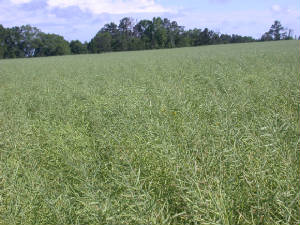|
|
Supplier of Premium Crop Genetics Rubisco Seeds LLC, P.O. Box 345, Philpot, KY 42366 | Phone:270.903.4994 | Fax: 270.729.4130 info@rubiscoseeds.com |
||
|
Rubisco Seeds: High Performance Hybrid Canola Seed |
|||
|
Canola Seed, Oil, Meal - What is Canola? ...Quick Canola Facts >Canola is a relatively new crop in the US and currently occupies approximately one million acres of cropland annually. The word "Can-o-l-a" is derived from "Canada-Oil-low acid" following selective breeding for lines of Brassica napus and Brassica rapa that contained less than 2% euricic acid and less than 30 micromoles of glucosinulates. >Canola seeds contain 40-46% oil with the remainder of the seed being processed into canola meal, a high protein livestock feed. The oil can also be used as a feedstock for Biodiesel. >Canola Oil has the lowest saturated fat and highest unsaturated fat of all vegetable oil, it's cholesterol-free and is a good source of the antioxidant vitamin E. >Canola oil contains linoleic acid (LA omega-6) and alpha-linolenic acid (ALA omega-3) essential fatty acids at 2:1 making it as one of the healthiest cooking oils, being only 2nd to flax for omega-3 levels. It has been shown through studies that the ALA found in canola oil has a positive effect on cholesterol, blood pressure and inflammation and comes with FDA approved health claims stating its effectiveness in reducing heart disease risk. Winter Canola Benefits >Winter rotational broadleaf crop >Diversification of cropping as a risk management tool >Excellent crop to control problem
grass weeds, grass related diseases and grass pests >No special equiment needed >Ideal for managing manure or litter resources >Crop Insurance available or RMA granted written agreement
(further questions?-contact us) >Local and Regional markets available >Proven yield increases on following crops: corn, wheat, beans (reference
bottom of this page) >Deep canola roots break compaction and recycle nutrients Difference between Canola and Industrial Rapeseed Differentials in oil and meal derived from canola, industrial rapeseed (H.E.A.R) and other members of the diverse Brassica family are outlined in a letter sent to all US Departments to increase awareness in all US States. View letter outlining differences to all State Departments Canola History Canola has both winter and spring adapted germ-plasm. The predominant production of this crop, that developed following FDA approval in the mid 1980's for canola oil in the food chain, has been focused on the fertile soils of the Northern Great Plains. In this region spring canola is planted in April/May and harvested in August/September. Spring canola has not migrated further south into the corn-belt due to its inability to tolerate relatively high mid-summer temperatures during critical pollinating and seed fill stages. The successful adaptation of winter canola in the US has developed at a much slower pace since the mid 1980's. Several regional attempts to commercialize the crop failed due to a variety of reasons including, poorly adapted germ-plasm, failure to refine production practices that simultaneously meet the needs of the farmers and the crop, handling and storage infrastructure limitations, fluctuations in global pricing and demand for vegetable oil and competition of other crops in the rotation. These challenges combined to discourage oilseed processors to view winter canola as a reliable crop with a consistent annual supply for dedicated processing facilities. A recent resurgence in domestic interest in winter canola in the first decade of this century can be contributed to two main sources of demand, namely, an increase in global demand for fuels derived from vegetable oils, and the recognition by the medical profession of the health risks linked to trans fats associated with hydrogenated vegetable oils. Canola oil serves as both an excellent feedstock for renewable fuels and a consumer friendly food oil not requiring hydrogenation. Two principle production regions for winter production have evolved in the US Midwest. Both of these regions draw heavily on the National Winter Canola Variety Trials (NWCVT results 2003-2012) facilitated through Kansas State University. The objectives of the NWCVT is to provide a multiple state network of winter canola germ-plasm evaluations to assist producers in selecting genetics for a particular region. Canola Growth In the southern plains a significant area of winter canola production, circa 80,000 acres has developed primarily in OK and southern KS to meet the needs of an Oklahoma City based oilseed processor. Limited commercial acres of winter canola are also being grown in TX and western MO by farmers interested in integrating this crop into their rotations. In the eastern corn-belt and southeast, there are pockets of consistently high yielding winter canola grown across multiple states, including, IL, IN, MO, KY, TN, AL, GA, SC, NC and VA. Yields obtained in this region over the last four years are on a par with yields obtained in traditional high yielding canola producing regions in western Europe and are typically 1.5 to 2 times the US national average for this crop. Farmer interest in the crop is predicted to continue in these and other regions driven by profitability and rotational benefits in following crops such as soybeans and wheat (see Table 1 below for a double-crop bean study depicting a 53% bean yield increase). Farmers in the southeast and the southern plains have also witnessed 10 to 20 bu/acre yield increases in winter wheat following canola over typical rotations. |
|
Double Cropping Soybean Study
|
||||||||||||||||||||
|
|
||||||||||||||||||||
|
Rubisco Seeds LLC * P.O. Box 345 * Philpot * KY 42366
*USA *Phone: (270) 903-4994 *Fax: (270) 729-4130 |

